Halara’s Move From TikTok Fame to SoHo Store
Halara, a TikTok-famous activewear brand, has taken a significant leap from its digital origins to the physical retail world. Opening its first-ever brick-and-mortar pop-up in New York City’s bustling SoHo neighborhood, Halara aims to translate its viral online success into a tangible shopping experience. This move is part of a broader trend among digital-first brands, increasingly experimenting with physical retail to create immersive brand experiences and deepen customer engagement.
Halara’s Social Media Success and Brand Evolution
Halara, which means “take it easy” in Greek, has leveraged the power of social media, particularly TikTok, to build a massive following since its founding in 2020. The brand’s trendy and affordable activewear has resonated with a young, fashion-conscious audience, making its products go viral multiple times. By using relatable content and engaging with influencers, Halara has successfully turned TikTok into a cornerstone of its marketing strategy.
The brand’s social media presence has not only driven sales but also fostered a strong community around its products. Customers frequently share their Halara outfits and experiences online, creating a continuous loop of user-generated content that further amplifies the brand’s reach. This online buzz has been pivotal in establishing Halara as a go-to name in the activewear market.
However, despite its digital prowess, Halara recognizes the limitations of an online-only presence. The inability to physically interact with products can be a barrier for some customers. This realization has led Halara to explore physical retail, starting with its pop-up store in SoHo.
The Pop-Up Store Phenomenon
The concept of pop-up stores has gained traction among digitally native brands looking to dip their toes into the world of physical retail. These temporary retail spaces offer a low-risk way to test the waters, allowing brands to engage with customers in a new environment without the commitment of a permanent storefront.
According to a 2021 report by Coresight Research, nearly one-third of digital-first brands plan to open brick-and-mortar stores within the next year. The primary motivation behind this trend is the desire to create more immersive brand experiences. Physical stores offer unique opportunities for sensory engagement and personalized customer interactions that are hard to replicate online.
Brands like Warby Parker, Glossier, and Casper have successfully used pop-up stores to build deeper connections with their customers and gather valuable insights. These temporary setups serve as both marketing tools and data collection points, helping brands refine their strategies based on direct consumer feedback.
Inside Halara’s SoHo Pop-Up Experience
Halara’s SoHo pop-up, open from June 3 to June 18, offers a comprehensive showcase of the brand’s product range, including its popular tennis skirts, leggings, and sports bras. The store is designed to be more than just a shopping destination; it is an experiential space where customers can fully immerse themselves in the Halara brand.
Visitors to the pop-up can expect interactive elements such as a photo booth and a customization station, where they can personalize their purchases. These features are designed to enhance the shopping experience and encourage social media sharing, thereby extending the brand’s online influence into the physical realm.
The feedback from customers has been overwhelmingly positive. Many appreciate the opportunity to touch and feel the products before making a purchase, and the personalized styling advice from Halara’s team has been particularly well-received. This hands-on experience is something that digital channels cannot provide, highlighting the complementary nature of online and offline retail.
The Future of Halara and Physical Retail
The success of Halara’s pop-up store in SoHo is likely to influence the brand’s future retail strategy. Co-founder and CEO Tricia Tan has indicated that if the pop-up proves successful, the company may consider opening permanent stores. This cautious approach allows Halara to gather insights and refine its physical retail model before making long-term commitments.
Halara’s venture into physical retail is part of a larger trend that reflects the evolving nature of the retail industry. As more digital-first brands explore brick-and-mortar options, the lines between online and offline retail continue to blur. This hybrid approach caters to diverse consumer preferences, offering the convenience of online shopping alongside the experiential benefits of physical stores.
The future of retail is likely to be characterized by a seamless integration of digital and physical experiences. Brands that can effectively combine these elements will be well-positioned to thrive in a post-pandemic world, where consumers expect flexibility and innovation in their shopping experiences.
Sources:
- Modern Retail
- Business Insider
- Forbes
- Retail Dive
- Shopify
